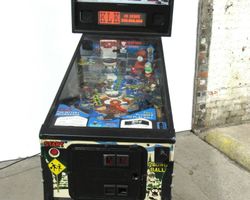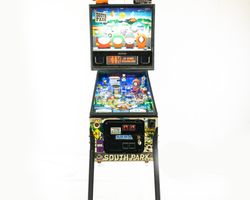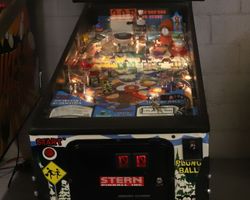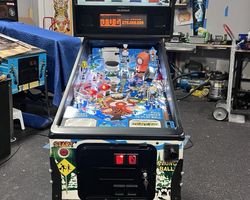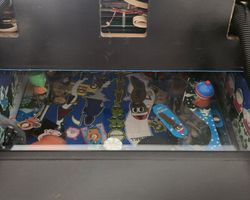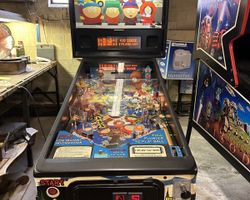South Park
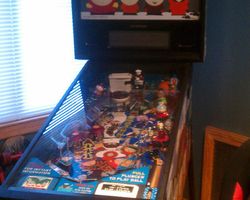
Average Prices: USD $1,400 to $3,500
Produced: Febuary, 1999
Production Run: 2,200 units
Machine Type: Solid State Electronic
MPU: Sega/Stern Whitestar
Players: 6
Concept by: Joe Kaminkow
Design by: Joe Kaminkow, Joe Balcer
Art by: Dave Link, Jason Dominiak
Dots/Animation by: Kurt Andersen
Mechanics by: Joe Balcer, Rob Hurtado
Music by: Kyle Johnson
Sound by: Kyle Johnson
Software by: Neil Falconer, Orin Day, Lonnie D. Ropp
South Park, released by Sega Pinball, Inc. in February 1999, brought the irreverent humor and distinctive characters of the popular animated television series to the pinball playfield. This solid-state electronic machine, model number 71, was a product of Sega's Whitestar generation, known for its robust electronics and dot matrix display capabilities. The inspiration was clear: leverage the widespread appeal and adult comedy of the South Park phenomenon.
The creation of the South Park pinball machine was a collaborative effort. Joe Kaminkow, a significant contributor to many pinball projects, spearheaded the design and concept. Software development was handled by a team including Jon Norris, Lonnie D. Ropp, Neil Falconer, and Orin Day, while Joe Balcer and Rob Hurtado were responsible for the machine's mechanical elements. The distinctive art package, crucial for a licensed title, was primarily the work of Dave Link, with Kevin O'Connor contributing some early sketches. Kyle Johnson crafted the machine's music and sound design, capturing the essence of the show, and Kurt Andersen handled the animation displayed on the dot matrix. With an initial production run of approximately 2,200 units, and potentially more in a second run, South Park made its mark on the late 90s pinball market as a direct translation of a prominent pop culture property. An interesting detail from its early production involved ROM versions that included more explicit content, such as a "Cartman eating carpet" video mode and stronger language, which were subsequently pulled at the request of Comedy Central due to their extreme nature. Sega Pinball also provided operators with a large arrow decal, allowing them to cover potentially objectionable playfield artwork to suit different environments.
Signature Features and Design
The South Park pinball machine is defined by its bold integration of the television show's unique aesthetic and characters into physical playfield elements. Central to its appeal are the custom toys and mechanisms that directly reference the source material. A prominent feature is the toilet-shaped ball holder, which serves as a crucial interactive toy. During multiball sequences, this toilet "flushes" balls into play, a whimsical and visually amusing action that ties directly into the show's often puerile humor.
Character figurines, including those of Cartman and Chef, are strategically placed on the playfield, acting as targets or visual anchors that draw players deeper into the thematic experience. Perhaps the most recognized mechanical toy is the oversized figure of Kenny, positioned above the "Kill Kenny" cave. This bash toy is designed to be repeatedly hit, triggering various thematic animations and sound effects related to the character's recurring on-screen demise. The backbox is further adorned with a Cartman topper, completing the machine's distinctive appearance. The use of custom speech, featuring the original voice actors from the television show, significantly enhances the thematic immersion, delivering authentic dialogue and catchphrases that resonate with fans. This commitment to accurate representation through both visual and auditory elements makes the machine instantly recognizable and highly engaging for fans of the show.
Playfield and Mechanics
The playfield of South Park by Sega Pinball is characterized by an open layout, providing clear lines of sight to its key shots. The design philosophy aimed for an approachable experience, with major targets and ramps positioned around the periphery of the playfield. The machine features two standard flippers at the bottom, offering control for shot accuracy. A single main ramp curves around the playfield, serving as a primary target for points and mode progression. Three pop bumpers located towards the upper-middle section of the playfield provide kinetic action and ricochet opportunities, while two slingshots flank the flippers, redirecting the ball with force.
Interactive toys are strategically integrated into the playfield flow. The toilet mechanism is a focal point, not just a visual prop, but a functional element for initiating multiball. The oversized Kenny figure serves as a bash toy, rewarding players for direct hits. The layout facilitates a relatively fast and free-flowing game, with shots that are generally considered accessible, contributing to its beginner-friendly nature. The artwork, primarily by Dave Link, directly translates the distinctive, often crude, animated style of the television show onto the playfield. This includes vibrant character depictions, familiar settings, and visual gags that enhance the thematic experience. Lighting on the playfield is employed to highlight active shots, indicate mode progress, and create an overall aesthetic that aligns with the bright, cartoonish world of South Park.
Gameplay Dynamics
The gameplay dynamics of South Park revolve around an accessible ruleset designed to engage players with its thematic elements and direct objectives. The game's progression is largely driven by completing character-specific modes, each tied to hitting designated shots on the playfield. For instance, players might aim for targets associated with Cartman, Chef, or other characters to advance through their respective modes. A central objective is the "Kill Kenny" cave, where players repeatedly hit the Kenny bash toy to score points and progress through a core sequence.
One of the game's highlights is its 5-ball multiball, frequently initiated by locking balls in the toilet mechanism and watching them "flush" into play. This chaotic, high-scoring event provides a burst of excitement, often accompanied by thematic call-outs. While the rule set is not overly complex, it offers clear objectives that guide players through the game. The ease of hitting shots contributes to a relatively straightforward scoring system, making it rewarding for casual players to achieve satisfying scores and engage with the game's humor. Despite its relative simplicity, the game does feature a wizard mode, though reaching it can involve repetitive shot sequences. Player strategy often focuses on consistently hitting the character-specific targets to activate modes and successfully initiate multiball for high scores, all while enjoying the constant stream of custom speech and animations that define the South Park experience.
Reception and Legacy
The reception of South Park in the pinball community has been mixed, though generally positive, particularly among fans of the animated series. Its most undeniable strength lies in its exceptional theme integration. Reviewers consistently praise the machine for its accurate representation of the South Park universe, from the distinctive artwork and character likenesses to the authentic sound effects, custom speech featuring the original voice actors, and the show's signature humor. This commitment to thematic fidelity creates an immersive experience that resonates deeply with fans, making the game inherently fun and enjoyable for them. The interactive toys, especially the toilet multiball mechanism and the animated Kenny bash toy, are frequently cited as engaging features that contribute to the machine's appeal. Furthermore, its approachable ruleset and generally easy-to-hit shots make it accessible for beginners and casual players, providing a good entry point into the hobby.
However, the machine is not without its criticisms. The most common feedback points to repetitive gameplay and a relatively shallow ruleset. Experienced pinball players often find the objectives and shot sequences repetitive, leading to a lack of long-term depth. The open playfield design, while contributing to accessibility, can also result in less flow and challenge for skilled players. Some also note that while the audio is initially amusing, the repetitive nature of certain call-outs can become tiresome over extended play. Additionally, the right drain lane is often mentioned as being particularly unforgiving. Despite these critiques, South Park's legacy is solidified by its strong thematic appeal and its place as a recognizable licensed title from the late 1990s. It stands as an example of Sega Pinball's strategy during that era to combine popular intellectual properties with accessible pinball design. While it may not be lauded for its deep strategic complexity, it remains a sought-after machine for collectors who prioritize direct, humorous theme integration and an enjoyable, lighthearted pinball experience.
Sponsored Links
 Ebay Listings
Ebay Listings
 Auction Results
Auction Results
| Cost | Location | Date |
|---|---|---|
| USD $7,499 |  California, United States California, United States |
15 May, 2025 |
| USD $7,000 |  Florida, United States Florida, United States |
04 May, 2025 |
| USD $5,000 |  New Jersey, United States New Jersey, United States |
01 May, 2025 |
| EUR €5,000 |  Nordrhein-Westfalen, Germany Nordrhein-Westfalen, Germany |
31 March, 2025 |
| USD $5,400 |  New York, United States New York, United States |
14 March, 2025 |
| USD $7,499 |  California, United States California, United States |
10 March, 2025 |
| USD $4,750 |  New Jersey, United States New Jersey, United States |
18 February, 2025 |
| USD $8,999 |  California, United States California, United States |
18 January, 2025 |
| USD $8,999 |  California, United States California, United States |
15 December, 2024 |
| USD $4,400 |  Pennsylvania, United States Pennsylvania, United States |
29 January, 2024 |


Private Policy · Search Website · Contact Us
As an eBay Partner, we may earn a commission from qualifying purchases made through links on this site, at no additional cost to you.
All trademarks and copyrighted materials remain property of their respective owners. All other content copyright 2007 - 2025 Pinpedia.

